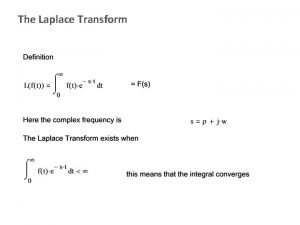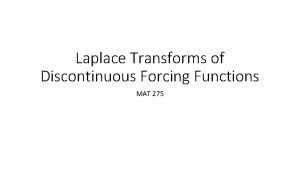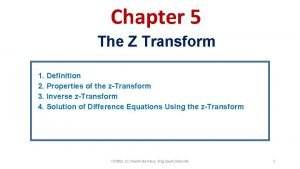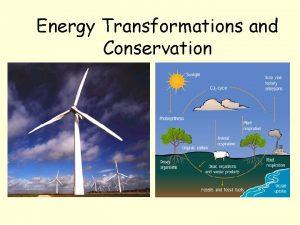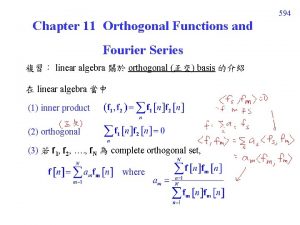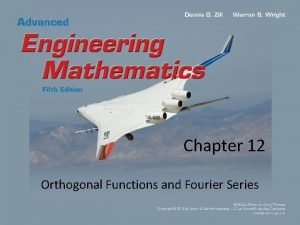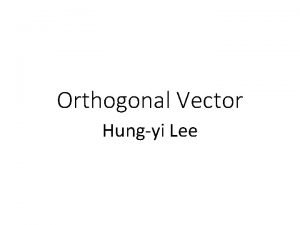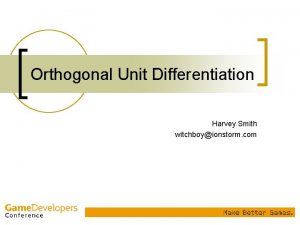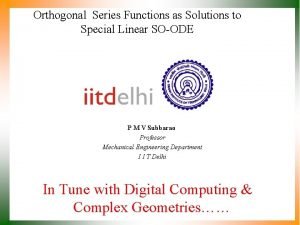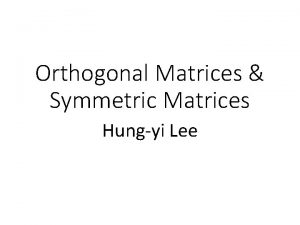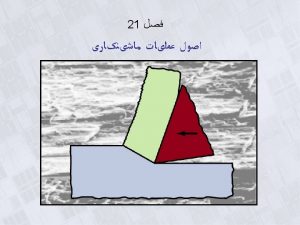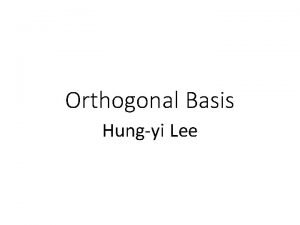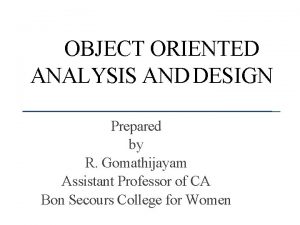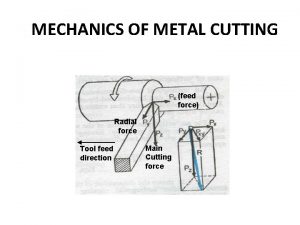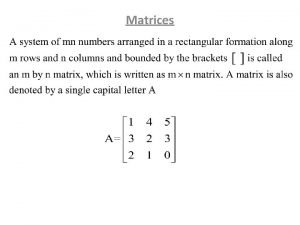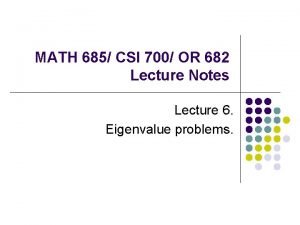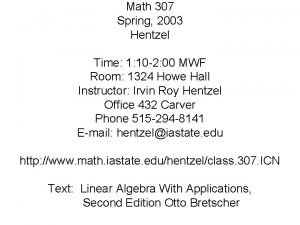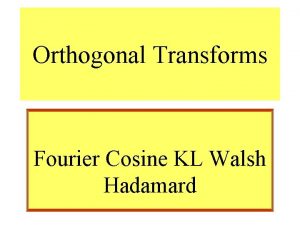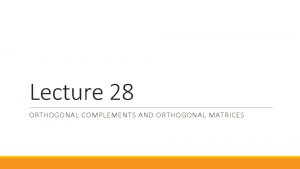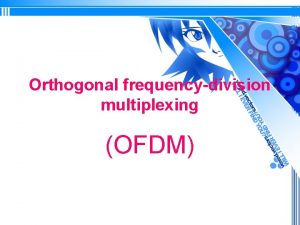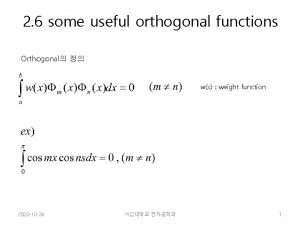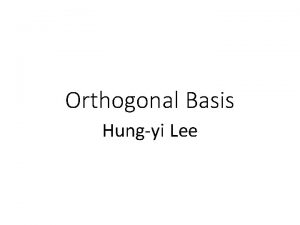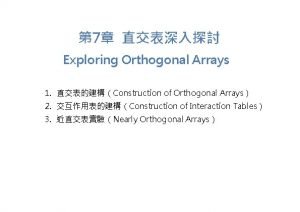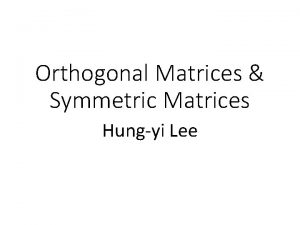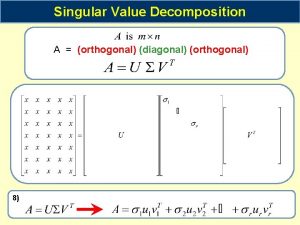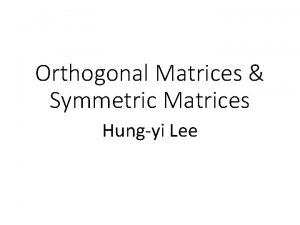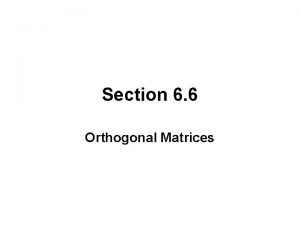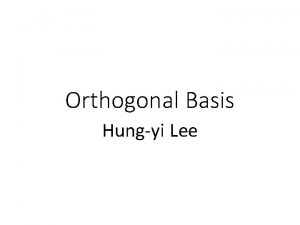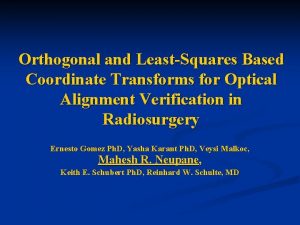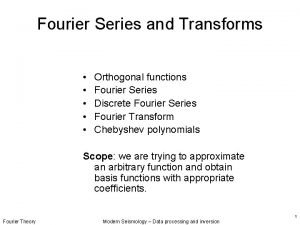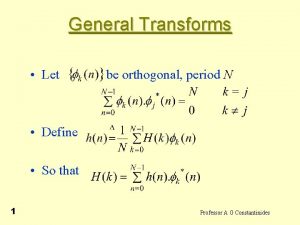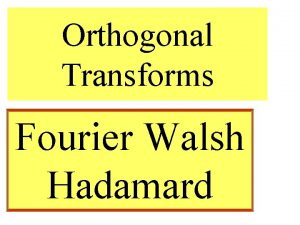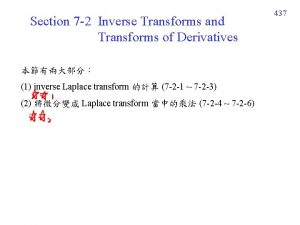Image Transforms WenNung Lie 2 D orthogonal and

































- Slides: 33

Image Transforms Wen-Nung Lie

2 -D orthogonal and unitary transforms ■ Orthogonal series expansion for an N N image u(m, n) v(k, l) N 1 u(m, n)a (m, n) 0 k, l N 1 v(k, l)a (m, n) 0 m, n N 1 k , l m 0 n 0 u(m, n) N 1 * k , l k 0 ■ ■ l 0 v(k, l)’s are the transform coefficients, V {v(k, l)} represents the transformed image {a k , l (m, n)} is a set of orthonormal functions, representing the image transform 5 -1

Orthonormality and completeness ■ {a k , l (m, n)}must satisfies N 1 orthonormality : a m 0 k 0 (m, n)a k* , l (m, n) (k k , l l ) n 0 N 1 completeness : k , l a k , l (m, n)a k*, l(m , n ) (m m , n n ) l 0 5 -2

Matrix representation of image transform ■ v(k, l) N 1 u(m, n)a k , l (m, n) m 0 n 0 u(m, n) ■ ■ k 0 F, G v(k, l)a k*, l (m, n) l 0 N 1 f (m, n)g (m, n) * m 0 ■ v(k, l)A * k , l l 0 N 1 k 0 ■ U N 1 v(k, l) U, A *k , l is the matrix inner product n 0 Image U can be described as a linear combination * 2 A of N matrix k , l , k, l = 0, . . . , N-1 A *k , l are called the basis images v(k, l) can be considered as the projection of u(m, n) on the (k, l)-th basis image 5 -3

■ Basis images 5 -4

2 -D Separable image transformation ■ {ak , l (m, n)} is separable ak , l (m, n) ak (m)bl (n) a(k , m)b(l, n) N 1 v(k , l) a(k , m)u(m, n)a(l, n) m 0 n 0 N 1 V AUAT u(m, n) a * (k , m)v(k , l)a * (l, n) U A *TVA * k 0 l 0 ■ ■ A {a(k, m)} B {b(l, n)} are unitary matrices Consider the above as “transforming columns of U by A, then transforming rows of the result by A T 5 -5

Properties of unitary transform ■ Given v Au (A is a unitary transform) 2 ■ ■ v u 2 , i. e. , energy-conserved a unitary transformation is a rotation of the basis coordinates , or a rotation of the vector u in NDimensional vector space Unitary transform tends to concentrate most of the signal energy on a small set of transform coefficients µ v Aµ u R v AR u A*T

Properties of unitary transform (cont) ■ ■ The transform coefficients tends to be decorrelated, i. e. , the off-diagonal elements of R v are approaching zero The entropy of a random vector is preserved under a unitary transformation (i. e. , information preserved)

1 -D DFT ■ 1 -D DFT pair (unitary transformation) v(k ) 1 N 1 N u(n)W Nkn k 0, . . . , N 1 1 v(k )WN kn n 0, . . . , N 1 n 0 u(n) N 1 N k 0 j 2 � WN exp� � � �N � ■ N×N transform matrix F for v Fu � 1 � F � WNkn � , � �N 0 k, n N 1

Properties of DFT ■ ■ Symmetry F F T € F 1 F * (unitary : F 1 F *T ) FFT needs O(N log N ) operations (DFT needs O(N 2)) Real DFT is conjugate symmetrical about N/2 2 ■ v*( ■ N N k ) v( k ) 2 2 x 2 (n) is the circular convolution between h(n) and x 1(n) DFT {x 2 (n)} N DFT {h(n)} N DFT {x 1 (n)} N ■ Extend the length of h(n) ( N ) and x (n) (N) with zeros to have the same length ( M N N 1 ), the above equation can be used to compute linear convolution 1

2 -D DFT ■ 2 -D DFT is a separable transform 1 v(k, l) N 1 u(m, n) N ■ N 1 m 0 N 1 u(m, n)W Nkm. W Nln n 0 N 1 v(k, l)W k 0 0 k, l N 1 km N W N ln l 0 In matrix form V FUF T FUF 0 m, n N 1

Properties of 2 -D DFT ■ ■ Symmetric and unitary € F F and F F Periodic € v(k N , l N ) v(k, l) V FUF needs 2 N times of 1 -D FFT DFT of real images is conjugate symmetrical with respect to ( N , N ) 1 T * T 2 2 v(k, l) v * ( N k, N l) ■ N 2 basis images 1 WN (km ln) , 0 m, n N 1 N 0 k, l N 1

Plots of DFT

Cosine transform ■ ■ DCT (discrete cosine transform) � 1 , k 0, 0 n N 1 � N c(k, n) � � 2 cos (2 n 1)k , 1 k N 1, 0 n N 1 �N 2 N � 8× 8 2 -D DCT

Properties of DCT ■ ■ ■ DCT is real and orthogonal € C C and C C DCT ≠ Real {DFT} DCT can be calculated via FFT * 1 T v(k ) Re[ (k )W 2 k. N/ 2 DFT{u~(n)} N ] u~(n) u(2 n) � N 0 n ( ) 1 � ~(N n 1) u(2 n 1) 2 u � ■ For highly correlated data, DCT has good energy compaction. That is, for first-order stationary Markov sequence with correlation 1, DCT is approximate to KL transform

Sine transform ■ DST (discrete sine transform) (k, n) ■ Properties ■ ■ 2 (k 1)(n 1) , sin N 1 0 k, n N 1 DST is real, symmetric, and orthogonal. € ψ * ψ ψ T DST and DST-1 are the same in the form (cf. DCT) DST≠ Imagery {DFT} For first-order stationary Markov sequence with correlation (-0. 5, 0. 5), the energy compaction of DST is approximate to KL transform ψ 1

(Walsh-) Hadamard transform ■ Kronecker operator Hadamard matrix 1 1� 1 � � � H 1 2 � 1 1� ■ H n 1 � H n 1 H 1 1 � H n 1 2� H n 1 � � H n 1� Components of HT vector contain only 1 and -1 ■ The number of transitions from 1 to -1 is called sequency (like in the continuous case) H 3 1 � � 1 � 1 8� � 1� 1 1 1 1 1 1 1� 1 1� � 1 1 � 1 1� � 1 1 1 1 � � � 1 1 � 0 7 sequency 3 Not in order 4 1 6 2 5 5 -17

(Walsh-) Hadamard transform (cont. ) ■ Hadamard transform pair : v(k ) �v Hu � �u Hv 1 N 1 N u(m)( 1) b ( k , m ) , 0 k N 1 m 0 u(m) 1 N 1 v(k )( 1) N b ( k , m ) , 0 m N 1 k 0 b(k, m) n 1 k m i i 0 ■ i k i , mi 0, 1 Notice the disordering effect in the sequency in HT spectrum when filtering will be performed

Properties of Hadamard transform ■ ■ ■ H H * H T H 1 Real, symmetric, and orthogonal € Fast computation (only addition is needed) Can be decomposed into product of sparse matrix H Hn H n 1 � � 0 � �. � ~ 10 � H 1 2� � 0 � �. � 0� � ■ 1 0 0 . ~ n log 2 N . . . � � 0 1 1 0. . . � � 0. . 1 1� 1 0 0. . � � 0 1 1 0. . . � � � 0. . 1 1� v Hu ~n ~~ ~ u . . . u H HH H For highly correlated images, Hadamard transform also has good energy compaction

Plot of Hadamard transform

KL transform of 1 -D vector ■ For a real N× 1 random vector u with autocorrelation matrix R, KL transform of u is defined as v Φ*T u where Rφ φ , 0 k N 1 , i. e. , φ k’s are orthonormalized eigenvectors of R and φ k is the k-th column of reduces R to its diagonal form, i. e. , Φ RΦ Λ Diag{ } k ■ u Φ v k k *T k ■ ■ If we replace R with R 0 R µ µ T, then eigenmatrix of R 0 is the KL transform of u- KL transform is independent of the image data themselves, but related to its 2 nd-order statistics

KL transform of 2 -D image ■ ■ FFT, DCT, DST all are special cases of KL transform For an image u(m, n) of N×N pixels, its autocorrelation function denoted as r(m, n; m , n ) (or an N N R matrix), the basis images of the KL transform are k , l (m, n) : 2 N 1 r(m, n; m , n ) k , l (m, n) m 0 n 0 or Rψ i iψ i 2 0 k, l N 1 0 m, n N 1 i 0, . . . , N 2 1 ψi is the N 1 vector representation of k , l (m, n) 2

KL transform of 2 -D image (cont. ) ■ If R matrix is separable, then Ψ {ψ } of N N is also separable Kronecker R R 1 R 2 Ψ Φ 1 Φ 2 operator 2 2 i where Φj R j Φj*T Λ j, j 1, 2 € KL transform : v Ψ*T u or V Φ UΦ ■ *T * 1 2 Advantages of this separability : reduce the eigenvalue problem of R matrix ( N N ) into two eigenvalue problems of R 1, R 2 ( N N ) 2 2

Properties of the KL transform ■ Decorrelation ■ ■ ■ {v(k ), k 0, . . . , N 1} are uncorrelated and have zero mean is not unique, not necessarily be the eigenmatrix of R Minimum basis restriction error u ■ A N N v Im 1≦m≦N w B N N z Signal u is transformed via A to be v, clip the first m values by Im to form w, and transformed back to z via B。The basis restriction error is defined as N 1 � 2 1 1 J m E� u(n) z(n) � � Tr[E{(u z)*T}] N �n 0 � N

Properties of the KL transform (cont. ) ■ ■ ■ Find A KL and B KL (KL transform) such that J m is minimized for each value of m [1, N ]. (KL is effective in compacting the energy) Select A Φ*T and B Φ , AB I , and columns of are sorted according to their corresponding eigenvalues . . . 0 1 2 N 1 Minimum transmission rate at a given distortion ■ In a noisy channel, given a distortion specification, D 1 E[(u u. )*T (u u. )] N KL transform can, among all unitary transformation A (include A = I ), achieve the minimum transmission rate R(Φ*T ) R(A) u A (unitary) v. v channel u. A*T

An example of KL-transform ■ A 2 1 vector u, whose covariance matrix is 1 � � , 1 R � � � 1 � The KL transform is Φ Φ *T 1 1� 1 � � � 1 1� 2� E{[v(0)]2} 0 1 , E{[v(1)]2 } 1 1 1 ) max(0, 1 log 1 1 R(Φ) [max(0, log )] 2 2 2 comparing R(I) 1 [ 2 log ], 0 1 4 Let be small, say 1 R(Φ) R(I) v Φ u CCU, Taiwan Wen-Nung Lie 5 -26

Comparison of energy distribution between transforms ■ ■ ■ CCU, Taiwan Wen-Nung Lie For first-order stationary Markov process with large , DCT is comparable to KL With small , DST is comparable to KL For any , we can find a faster sinusoidal transform (DCT or DST) to substitute for the optimal KL transform which needs covariance matrix to compute transform basis vectors 5 -27

CCU, Taiw an Wen-Nung Lie 5 -28

CCU, Taiwan Wen-Nung Lie 5 -29

Singular Value Decomposition (SVD) ■ For an N×M matrix U (M N), we can find r orthogonal M× 1 eigenvector {φm } by using U TU , or find r orthogonal N× 1 eigenvector {ψ}m by using UU T (r is the rank of U) UTUφ m mφ m , m 1, . . . , r UUT and UTU have the UU Tψ m mψ m , m 1, . . . , r same eigenvalues U m=k m Note. In KL, R is ■ Matrix U can be described as U Ψ Λ Φ 1/ 2 CCU, Taiwan Wen-Nung Lie � � 1. Λ 1/ 2 � �. � 0 . . T r ψφ m m T m symmetrical, but U is not m 1 0 � � Called the spectral representation, � outer product expansion, or � singular value decomposition � (SVD) of U �� r 5 -30

Singular Value Decomposition (cont) Note: U is not symmetrical ■ SVD of U (diagonalization) : Λ Ψ UΦ 1/ 2 ■ ■ T U can be described as the composition of r matrix (corresponding to different m , called U’s singular values) If U is an N×M image, U can be described as an NM× 1 vector, also as { ψ , φ ; m 1, . . . , r} 1/ 4 m m m needing totally (M+N)r data and be more efficient than N×M or NM× 1 if r << M

Properties of SVD ■ We can compute ψm 1 Uφ m, m 1, . . . r m ■ , when knowing φ m U Ψ Λ 1/ 2 ΦT due to the same eigenvalue Energy conservation E u (m, n) 2 m m k ■ n m mψ mφ m , k r, as U’s k partial-sum ( m is Denote U k m 1 ordered) € U k is the optimal rank-k description, with approximation error T k 2 M m 1 N n 1 2 u(m, n) u k (m, n) r , m k 1, . . . , r m k 1 € The energy of each SVD spectral band ψ φ is T m m

Properties of SVD (cont) ■ For a given image, SVD can compact the largest energy for a specified number of transform coefficients (optimized independently) ■ ■ The maximal number of basis images for SVD is N, while for other transforms, it is N 2 For KL transform, it optimizes one set of ensemble with the same covariance matrix, resulting in the largest “average energy” in probabilistic sense
 Kl transform example
Kl transform example Image transforms in digital image processing
Image transforms in digital image processing Image transforms
Image transforms How does eurylochus justify killing the cattle
How does eurylochus justify killing the cattle Laplace inverse formula
Laplace inverse formula Transforming data into information
Transforming data into information Discontinuous forcing functions
Discontinuous forcing functions Walang sugat setting
Walang sugat setting Drama definition literature
Drama definition literature Inverse z-transform table
Inverse z-transform table Transforms eroded parts of earth's surface into lakes
Transforms eroded parts of earth's surface into lakes Pole vault energy transformation
Pole vault energy transformation Which phase transforms srs document into a form easily
Which phase transforms srs document into a form easily Piere simon laplace
Piere simon laplace Friction transforms mechanical energy to
Friction transforms mechanical energy to Z transform derivative
Z transform derivative Photosynthesis transforms light energy into chemical energy
Photosynthesis transforms light energy into chemical energy Generalized fourier series
Generalized fourier series Fourier series and orthogonal functions
Fourier series and orthogonal functions Analog image and digital image
Analog image and digital image Ndc computer graphics
Ndc computer graphics Orthonormal basis
Orthonormal basis Orthogonal unit differentiation
Orthogonal unit differentiation Orthogonal polynomials examples
Orthogonal polynomials examples Orthogonal range searching
Orthogonal range searching Norm preserving matrix
Norm preserving matrix Orthogonal cutting diagram
Orthogonal cutting diagram Orthogonal basis example
Orthogonal basis example Object basics in ooad
Object basics in ooad Unit of power
Unit of power Properties of orthogonal matrix
Properties of orthogonal matrix Orthogonal iteration
Orthogonal iteration Idempotent matrix properties
Idempotent matrix properties Orthogonal matrix properties
Orthogonal matrix properties




